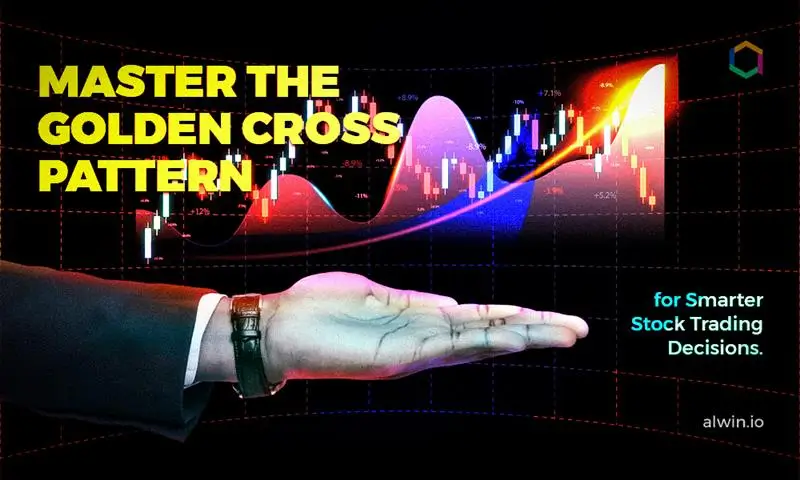The digital era is completely impressive and more technical, right? Data floods the screen, and strategies grow more complex by the day; sometimes, the most powerful signals are the simplest.
One such signal, trusted by technical analysts for decades, is the Golden Cross Pattern.
A Golden Cross occurs when a short-term moving average, typically the 50-day, crosses above a long-term moving average, usually the 200-day. This crossover is widely interpreted as a bullish signal, suggesting a shift from a downtrend to a potential long-term uptrend.
Why does it matter? Because many successful traders and long-term investors use it as a key confirmation signal, not only to enter trades but also to gauge market momentum. It's easy to spot, rooted in solid logic, and historically has appeared before major rallies across stocks, crypto, and indices.
Whether new to technical analysis or looking to sharpen your edge, this blog will give you everything you need to trade using the Golden Cross confidently.
What is the Golden Cross?
At its core, the Golden Cross is a bullish chart pattern that signals the potential beginning of a long-term uptrend. It happens when a short-term moving average, most commonly the 50-day simple moving average (SMA), crosses above a long-term moving average, usually the 200-day SMA.
This crossover is more than just a visual cue, it represents a significant shift in momentum. When the 50-day SMA moves above the 200-day SMA, it suggests that recent prices are rising faster than the longer-term average, indicating that buyer interest is increasing and the market sentiment is turning bullish.
Here's a breakdown:
Short-term MA (50-day): Represents recent price trends and reacts quickly to market changes
Long-term MA (200-day): This reflects the bigger picture and smooths out short-term volatility
The crossover: The point where the 50-day crosses above the 200-day is considered the “golden” moment
Traders and analysts often view the Golden Cross as a confirmation signal, not just a sign that momentum is shifting but that it may be sustainable over the longer term. That’s why it often draws attention from both short-term swing traders and long-term investors.
Anatomy of the Golden Cross
To fully understand the Golden Cross, it's helpful to break it down into its three key phases. Each phase reflects a shift in market psychology and price action. Together, they tell the story of a potential trend reversal from bearish to bullish.
Phase 1: The Downtrend Phase
In the early stage, the market is in a downtrend, and the short-term moving average (typically the 50-day SMA) remains below the long-term moving average (usually the 200-day SMA). This signals that recent price momentum is weaker than the broader trend, reflecting bearish sentiment and sustained selling pressure.
Traders usually avoid long positions here or may even be shorting the asset, as the trend is still negative.
Phase 2: The Crossover (Golden Moment)
This is the key event, the Golden Cross itself. It occurs when the short-term MA crosses above the long-term MA. This signals a shift in momentum, with recent prices starting to outpace the long-term average.
This moment is often interpreted as a bullish breakout, and many traders see it as a strong buy signal, especially if it's supported by rising volume or other confirming indicators.
Phase 3: The Uptrend Confirmation
After the crossover, the short-term MA continues to rise above the long-term MA, confirming the new uptrend. If the asset’s price also stays above both moving averages and volume supports the move, it increases confidence in the strength of the rally.
Long-term investors may see this as a good time to accumulate, while traders look for opportunities to ride the trend, often using pullbacks as potential entry points.
Historical Performance and Examples
The Golden Cross isn't just a theoretical concept, it has a strong track record of appearing before some of the most significant market rallies. While it's not a guarantee of future performance, its history does make a compelling case for paying attention when it appears.
S&P 500 – March 2019: The Classic Index Signal
In March 2019, the S&P 500 formed a textbook Golden Cross following a steep correction in late 2018. This crossover marked the start of a strong rally that carried well into early 2020, only cut short by the COVID-19 crash. Traders and investors who trusted the signal saw gains of nearly 40%, showcasing how the Golden Cross can confirm bullish momentum in major indices.
Bitcoin – May 2020: Crypto’s Bullish Trigger
In May 2020, Bitcoin printed a clean Golden Cross just months after the pandemic-driven crash. What followed was one of the asset's most explosive bull runs, from $9,000 to over $64,000 in under a year. With a gain of more than 600%, this Golden Cross became a textbook case of how powerful the pattern can be, even in high-volatility markets like crypto.
Apple – April 2020: Earnings and Technical Alignment
In April 2020, Apple beat earnings estimates for the 16th straight quarter while trading above a Golden Cross, confirming strong technical momentum. The stock bounced off a key support at $272.81 and closed at $310.13, up nearly 46% from its March low. This bullish setup perfectly reflected the headline: “Apple Beats Estimates and Trades Above a Golden Cross.”
Nasdaq-100 – August 2021: A False Start
Not all Golden Crosses lead to major rallies. In August 2021, the Nasdaq-100 flashed a bullish crossover, but the market lacked volume and faced macro headwinds like inflation concerns. Instead of surging higher, prices moved sideways before dipping. This example underscores that while the Golden Cross is a reliable confirmation tool, it’s not immune to false positives, especially in uncertain environments.
Golden Cross vs Death Cross
The Golden Cross has a bearish twin, the Death Cross. While the Golden Cross signals the start of a potential uptrend, the Death Cross warns of possible downward momentum. Understanding both helps traders navigate market reversals more confidently.
How to Use the Golden Cross in Trading?
The Golden Cross isn’t just a feel-good bullish signal - when used strategically, it can help traders time entries, manage risk, and ride trends more confidently. Here's how to use it in your trading plan:
1. As a Long-Term Bullish Signal
The Golden Cross is best viewed on daily or weekly charts and is most reliable for long-term trend confirmation. It’s less useful for short-term scalping but great for position traders and long-term investors who want to enter during trend reversals or strengthen their conviction.
Use it when:
The market has recovered from a downtrend
The crossover is confirmed with volume and follow-through
Fundamentals align (e.g., earnings growth, macro trends)
2. Entry and Exit Strategies
Entry Point:
Enter after the 50-day MA crosses above the 200-day MA, ideally on a pullback to either MA with bullish confirmation (e.g. bounce off support or rising volume).
Exit Point:
Exit partially at resistance zones or overbought conditions (e.g., RSI > 70) or when a Death Cross begins to form (50-day MA curling down below the 200-day MA).
Tip: Avoid entering on the day of the crossover. Wait for a candle to close above it with volume.
3. Combine with Other Indicators
To improve the reliability of a Golden Cross, combine it with indicators like RSI for momentum, MACD for trend strength, and volume to confirm breakout validity. Also, use support and resistance levels to refine entries and manage risk effectively.
4. Risk Management Tips
Even with a strong signal, smart risk management is key. Set a stop-loss below recent support or the 200-day MA, avoid oversized positions, and monitor macro events like rate hikes or earnings shocks. Since the Golden Cross is a lagging indicator, protect your capital as the signal plays out.
Limitations of the Golden Cross
While the Golden Cross is a popular and widely followed indicator, it’s important to understand its limitations. First, it’s a lagging indicator, meaning it often confirms a trend only after it has already begun, sometimes missing the early, most profitable moves. Second, it can generate false positives in sideways or choppy markets, where moving averages frequently cross without a sustained trend.
Lastly, it tends to work best in strongly trending markets, so relying on it alone during periods of low volatility or consolidation may lead to misleading signals. For best results, traders should use it in conjunction with other tools and a broader market context.
Tools to Spot the Golden Cross
Spotting a Golden Cross has never been easier, but popular charting platforms like TradingView, StockCharts, and ThinkorSwim guide you to trade in this volatile market. These platforms allow users to overlay the 50-day and 200-day moving averages on any asset chart. Traders do not need to monitor charts all day; you can save time by setting alert notifications when a crosscover occurs.
Beginners, start by selecting your asset, applying the Simple Moving Average (SMA) indicator twice (once set to 50 and once to 200), and watching for the crossover. It’s also helpful to use the daily time frame for stronger signals and combine with volume indicators or trendlines to boost confirmation. Most tools also offer mobile app integration so you can track potential Golden Cross setups on the go.
Final Thoughts
The Golden Cross remains one of the most recognized bullish indicators in technical analysis. When confirmed by volume and supported by broader market sentiment, it can help traders identify strong, long-term uptrends. However, as with any indicator, it’s not foolproof; false signals can occur in sideways or highly volatile markets.
Rather than relying on it alone, smart traders combine the Golden Cross with tools like RSI, MACD, and key support/resistance levels. Used as part of a broader strategy with solid risk management, it becomes a valuable tool for confirming trends, not predicting them.
If you're navigating the crypto space, especially in building your cryptocurrencyexchange platform, understanding technical patterns like the Golden Cross is crucial. As a leading Cryptocurrency Exchange Development Company, we empower businesses with advanced trading features and real-time market analytics, so your platform supports inf



